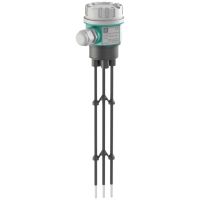Measurement principle
The conductivity of a liquid medium may vary widely. Once the liquid reaches the fill limit determined from the installation height of the electrode, the liquid medium closes the DC free alternating current circuit between the two electrodes (or between the container wall and an electrode). A switching signal is produced from the sudden increase in current consumption.
Acids, lyes and solutions containing water are conductive and are detected very well. Aggressive liquids can be detected without problems using probes made from highly-resistant materials. Combustible liquids such as fuels, oils and solvents are nonconductive and cannot be measured by this measurement principle.
Operation mode
Two electrodes are installed above the surface of the conductive liquid to be monitored. If the liquid level rises to the point where both electrodes are in contact with the liquid, the current circuit of a connected relay is completed via the two electrodes and the liquid, activating a switching signal.
The minimum conductivity of the liquid must be 10 µS/cm. These conditions are fulfilled by practically all conductive liquids, such as water, acids and lyes, with the exception of pure solvents.
If several switching points are needed, multiple electrodes should be used. In order to avoid electrical effects in the liquid, a DC free alternating current is used for measurement. This is generated by an electrode relay or a converter.
Interfacial level detection can be easily and economically achieved with this measurement method. Particularly with oil and petrol separators, the limit value between the water and the nonconductive liquid is easy to detect.






 +45 7010 4210
+45 7010 4210